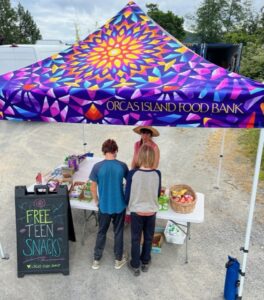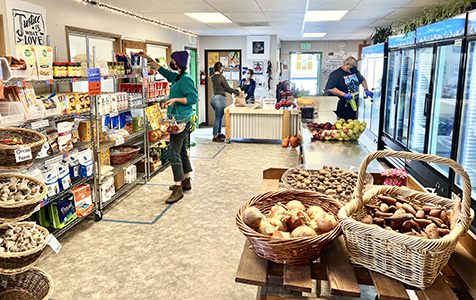||| BY ELLIE WRIGHT, theORCASONIAN INTERN |||
In 1948, the Universal Declaration of Human Rights was signed by the United Nations, enshrining the rights and freedoms of all human beings. On that declaration, food was affirmed as a basic human right. Yet still, according to the USDA, over 34 million Americans go hungry every year. Organizations like the Orcas Island Food Bank (OIFB) work to improve those conditions.
On average, a family of four saves about $600 per month, assuming a weekly visit to the Food Bank. In these visits, the Food Bank provides customers with access to fresh produce, local meats, pre-made meals, and other food staples. The OIFB supports healthy food choices and is about to implement the SWAP ranking system to inform customers on which foods they should eat often, sometimes, or rarely.
The OIFB currently operates off a hybrid “self-select” and “hand-select” model. In the self-selection model, customers move down a counter and tell a Food Bank staff member what items they want from shelves behind the counter, as the staffer fills the bag with those items. The hand-selection model allows for shopping in a supermarket style, with customers selecting items they want from shelves, and adding them to a basket or cart. In the hybrid model, shoppers hand-select packaged and canned goods, while a staff member bags the produce, protein, and dairy that they want. The end goal of the OIFB is a fully supermarket-style shopping experience. The organization wants to allow for as much independence as possible when it comes to selecting food.
Just as the COVID-19 pandemic changed much of our lives, it changed the way the Food Bank operated. More households needed the support of the OIFB, and they needed to operate in a way that could keep up with the demand and keep customers and staff safe. At the beginning of the pandemic, they switched from a hand-selection model to pre-packed bags. However, the pre-packed bags increased the probability of food being wasted and reduced the self-agency of customers. In April of 2020, they moved to an outside self-select model. During the pandemic, weekly visits to the Food Bank increased by 300%. Food distribution hours increased from 2.5 hours a week to 16.5.

The Food Bank offers many programs to the island community other than just grocery distribution. They run the “Teen Tent,” a tent set up outside of the OIFB, offering healthy snacks, beverages, and fruit to local teens. Last September, they hosted a fiesta along with Alimentando al Pueblo, as a celebration of Latinx culture and food.
The OIFB works to end the stigma around hunger relief and ensure that everyone receives the help they need. Their doors are open for food distribution Monday from 3:00-6:30 p.m. and Tuesday and Friday from noon to 6:30, except for federal holidays. For more information, visit www.orcasislandfoodbank.org.
**If you are reading theOrcasonian for free, thank your fellow islanders. If you would like to support theOrcasonian CLICK HERE to set your modestly-priced, voluntary subscription. Otherwise, no worries; we’re happy to share with you.**









Great article, Ellie, along with the photo. Very informative and a great step for our Food Bank and the community members it serves. Another transformation led by the incredible Amanda Sparks! and the board.